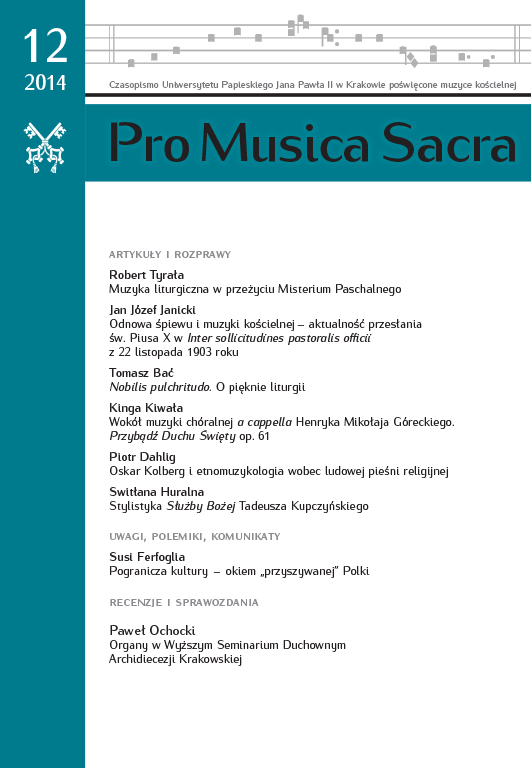La Música litúrgica en la reflexión sobre el Misterio Pascual
DOI:
https://doi.org/10.15633/pms.1511Keywords:
liturgical music, Paschal Triduum, choir singing and lay brother’s singing, Mass of the Lord’s Supper, Liturgy of the Passion, Easter VigilAbstract
If “the music is an integral part of the solemn liturgy” (SC 112) it is tremendously important that during the crucial ceremonies at churches, particularly those involving liturgical celebrations, it would become its clear sign. Since, when we prepare liturgical music we always draw our special attention to: liturgical year, namely, to a particular season, feast or celebration, examining the contents of the holy mass antiphon (referring to entrance songs and the holy communion), the mass order, the collect and the readings, especially the Gospel. And this entire content of liturgical prayers and readings is to be reflected through music of the celebrations. Therefore the music becomes integral because its role is not merely supplementary, complementary, substitutive nor decorative, but incorporated in liturgy with which it is inextricably linked. Music springs from liturgy and leads to liturgy. It enriches mass liturgy, makes it more grandly and clearly rendered.
It should be no different during the Easter Triduum for which the music ought to be even more thoroughly prepared as for the most important season of the liturgical year, that is, the Feast of Christ, suffering, crucified and resurrected. As it is the greatest event of the mystery of redemption observed here and now. The importance of the Easter Triduum was indicated by Pope Benedict XVI during his General Audience on 19 March 2008. May his words serve as the conclusion of my speech:
These three days are commonly known as ‘holy’ because they allow us to re live the event central to our Redemption. They lead to nucleus of Christian faith: the passion, Heath, and resurrection of Jesus Christ. These three days could be considered as one single day. They make up the heart and are the key to both the liturgical year and the life of the Church. … Remembering the mysteries of Christ also means a willing and complete adherence to the history of today, convinced that when we celebrate, it is vivid and present reality… These holy days reawaken a great hope in us: Christ was crucified, yet he rose again and conquered the world. Love is stronger than hate, it has triumphed and we should affiliate ourselves with this victory of love. We should therefore start again from Christ and work together with him for a world founded on peace, justice and love.
References
Benedykt XVI, Udienza Generale, (19 03. 2008), www.vatican.va/holy_father/benedict_xvi/audiences/2008/documents/hf_ben-xvi_aud_20080319_it.html
Congregatio pro Culto Divino, Letterae circulares Paschalis sollemnitatis. De festis paschalibus praeparandis et celebrandi (16 I 1988), „Notitiae” 24 (1988), pag. 81-107.
Congregación para el Culto Divino, Carta circular dada en la sede de la Congregación para el Culto Divino y la Disciplina de los Sacramentos La preparación y celebración de
las fiestas pascuales, www.aciprensa.com/Docum/documento.php?id=95.
Nadolski B., Liturgika, t. 2, Liturgia i czas, Poznań 1991.
Downloads
Published
Issue
Section
License
Authors who publish with this journal agree to the following terms:
- Authors retain the copyright and full publishing rights without restrictions, and grant the journal right of first publication with the work simultaneously licensed under a Creative Commons Attribution 4.0 International License that allows others to share the work with an acknowledgement of the work's authorship and initial publication in this journal.
- Authors are able to enter into separate, additional contractual arrangements for the non-exclusive distribution of the journal's published version of the work (e.g., post it to an institutional repository or publish it in a book), with an acknowledgement of its initial publication in this journal.
- Authors are permitted and encouraged to post their work online (e.g., in institutional repositories or on their website) prior to and during the submission process, as it can lead to productive exchanges, as well as earlier and greater citation of published work (See The Effect of Open Access).

